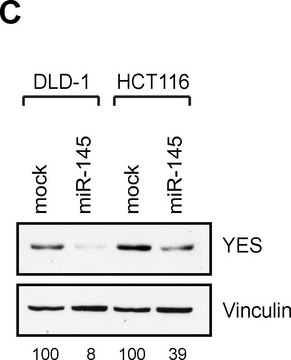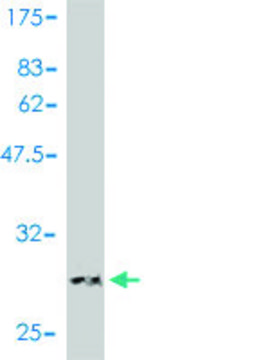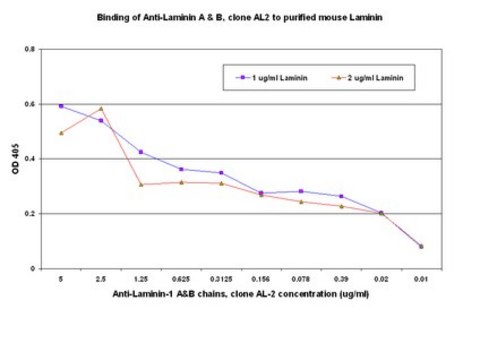General description
We are committed to bringing you greener alternative products, which adhere to one or more of The 12 Principles of Green Chemistry. This antibody is Preservative-free, produced without the harm or sacrifice of animals and exceptionally stable to allow for ambient shipping and storage if needed and thus aligns with "Waste Prevention", "Designing Safer Chemicals" and "Design for Energy Efficiency".
Click here for more information.
ZooMAb® antibodies represent an entirely new generation of recombinant monoclonal antibodies. Each ZooMAb® antibody is manufactured using our proprietary recombinant expression system, purified to homogeneity, and precisely dispensed to produce robust and highly reproducible lot-to-lot consistency. Only top-performing clones are released for use by researchers. Each antibody is validated for high specificity and affinity across multiple applications, including its most commonly used application. ZooMAb® antibodies are reliably available and ready to ship when you need them.
Specificity
Clone 1N11 is a ZooMAb® rabbit recombinant monoclonal antibody that specifically detects CD3 / CD247. It targets an epitope within 22 amino acids from the C-terminal half.
Immunogen
KLH-conjugated linear peptide corresponding to 22 amino acids from the C-terminal half of human CD3 /CD247.
Application
Quality Control Testing
Evaluated by Western Blotting in Jurkat cell lysate.
Western Blotting Analysis: A 1:10,000 dilution of this antibody detected CD3 /CD247 in Jurkat cell lysate.
Tested Applications
Western Blotting Analysis: A 1:10,000 dilution from a representative lot detected CD3 /CD247 in Human spleen tissue lysate.
Immunocytochemistry Analysis: A 1:100 dilution from a representative lot detected CD3 /CD247 in Jurkat cells.
Immunohistochemistry (Paraffin) Analysis: A 1:1,000 dilution from a representative lot detected CD3 /CD247 in human tonsil tissue sections.
Affinity Binding Assay: A representative lot of this antibody bound CD3 with a KD of 5.0 x 10-7 in an affinity binding assay.
Flow Cytometry Analysis: 0.1 µg from a representative lot detected CD3 /CD247 in one million Jurkat cells.
Note: Actual optimal working dilutions must be determined by end user as specimens, and experimental conditions may vary with the end user.
Target description
T-cell surface glycoprotein CD3 zeta chain (UniProt: P20963; also known as T-cell receptor T3 zeta chain, CD247) is encoded by the CD247 (also known as CD3Z, T3Z, TCRZ) gene (Gene ID: 919) in human. CD3 ζ is a single-pass type I membrane protein that is synthesized with a signal peptide (aa 1-21), which is subsequently cleaved off to generate the mature form that contains a short extracellular domain (aa 22-30), a transmembrane domain (aa 31-51), and a cytoplasmic domain (aa 52-164). CD3ζ is expressed in normal lymphoid tissues and in peripheral blood mononuclear cells (PBMC). It is a part of the TCR-CD3 complex that is present of the surface of T-cells and plays an essential role in adaptive immune response. When antigen presenting cells (APCs) activate T-cell receptor (TCR), TCR-mediated signals are transmitted across the cell membrane by various CD3 chains (CD3D, CD3E, CD3G and CD3Z). These chains contain immunoreceptor tyrosine-based activation motifs (ITAMs) in their cytoplasmic domain. The ITAM motifs CD3ζ are localized to amino acids 61-89; 100-128; and 131-159. These motifs are reported to be phosphorylated by Src family protein tyrosine kinases Lck and Fyn, resulting in the activation of downstream signaling pathways. In CD3 ζ phosphorylation of ITAMs by Lck is reported to be an initial step in the transduction of signaling cascades. It creates multiple docking sites for protein kinase ZAP70, which is also phosphorylated by Lck. Phosphorylation of ZAP70 converts it into a catalytically active form. It is reported that CD3ζ phosphorylation can also be promoted by ZAP70 and TCR-induced zeta phosphorylation is shown to be defective in ZAP70-deficient T-cells. This ZooMAb® recombinant monoclonal antibody, generated by our propriety technology, offers significantly enhanced specificity, affinity, reproducibility, and stability over conventional monoclonals. (Ref.: Iwashima, M., et al. (1994). Science. 263(5150); 1136-1139; Barber, EK., et al. (1989). Proc. Natl. Acad. Sci. USA. 86(9); 3277-3281).
Physical form
Purified recombinant rabbit monoclonal antibody IgG, lyophilized in PBS, 5% Trehalose, normal appearance a coarse or translucent resin. The PBS/trehalose components in the ZooMAb formulation can have the appearance of a semi-solid (bead like gel) after lyophilization. This is a normal phenomenon. Please follow the recommended reconstitution procedure in the data sheet to dissolve the semi-solid, bead-like, gel-appearing material. The resulting antibody solution is completely stable and functional as proven by full functional testing. Contains no biocide or preservatives, such as azide, or any animal by-products. Larger pack sizes provided as multiples of 25 µL.
Reconstitution
Reconstitute lyophilized antibody pellet with 25μL of ultrapure water or Phosphate Buffered Saline (PBS). Please refer to our
reconstitution protocol and the specific application guidance on the suggested starting dilutions and sample type.
Storage and Stability
Recommend storage of lyophilized product at 2-8°C; Before reconstitution, micro-centrifuge vials briefly to spin down material to bottom of the vial; Reconstitute each vial by adding 25 µL of filtered lab grade water or PBS; Reconstituted antibodies can be stored at 2-8°C, or -20°C for long term storage. Avoid repeated freeze-thaws.
Other Notes
Concentration: Please refer to the Certificate of Analysis for the lot-specific concentration.
Legal Information
ZooMAb is a registered trademark of Merck KGaA, Darmstadt, Germany
Disclaimer
Unless otherwise stated in our catalog or other company documentation accompanying the product(s), our products are intended for research use only and are not to be used for any other purpose, which includes but is not limited to, unauthorized commercial uses, in vitro diagnostic uses, ex vivo or in vivo therapeutic uses or any type of consumption or application to humans or animals.














